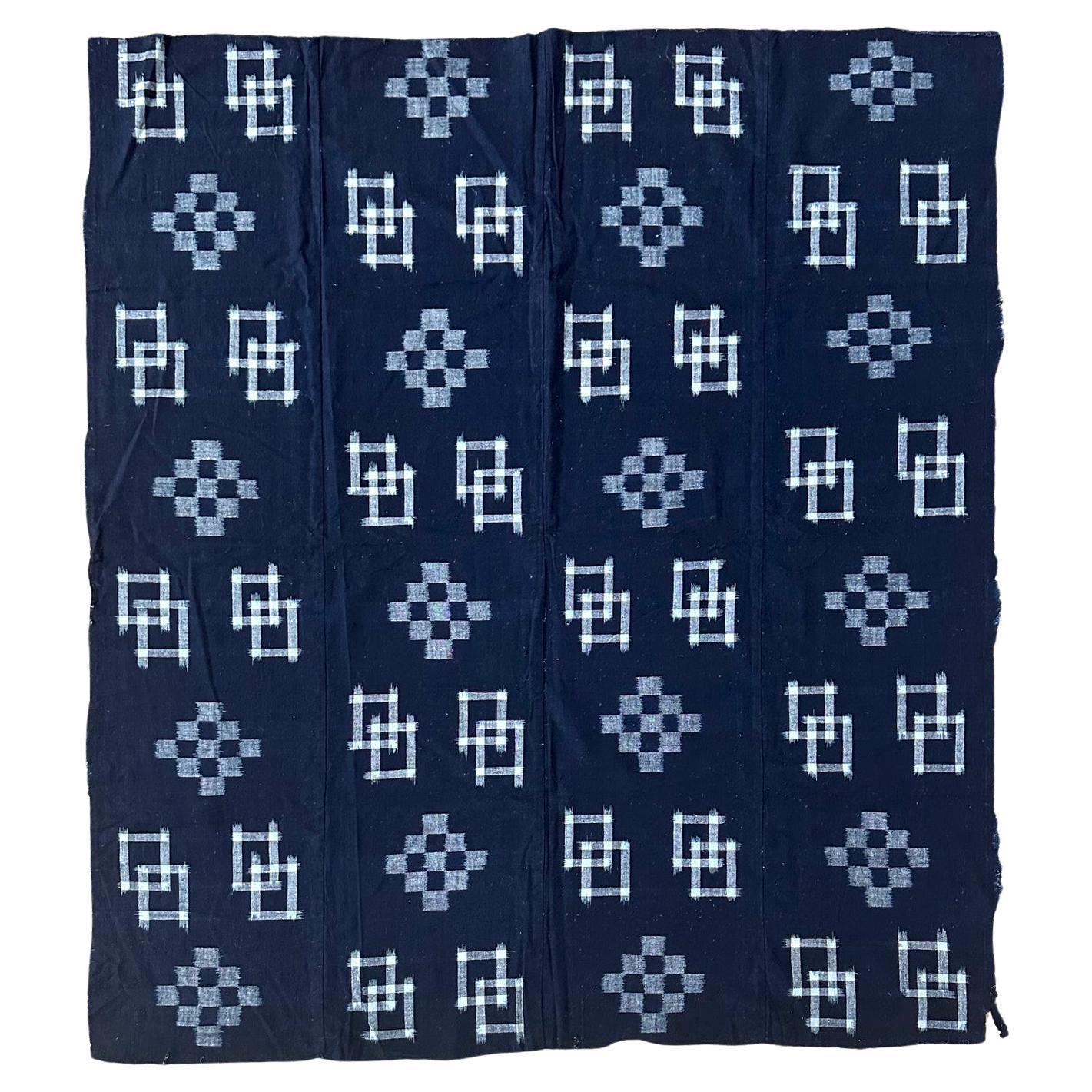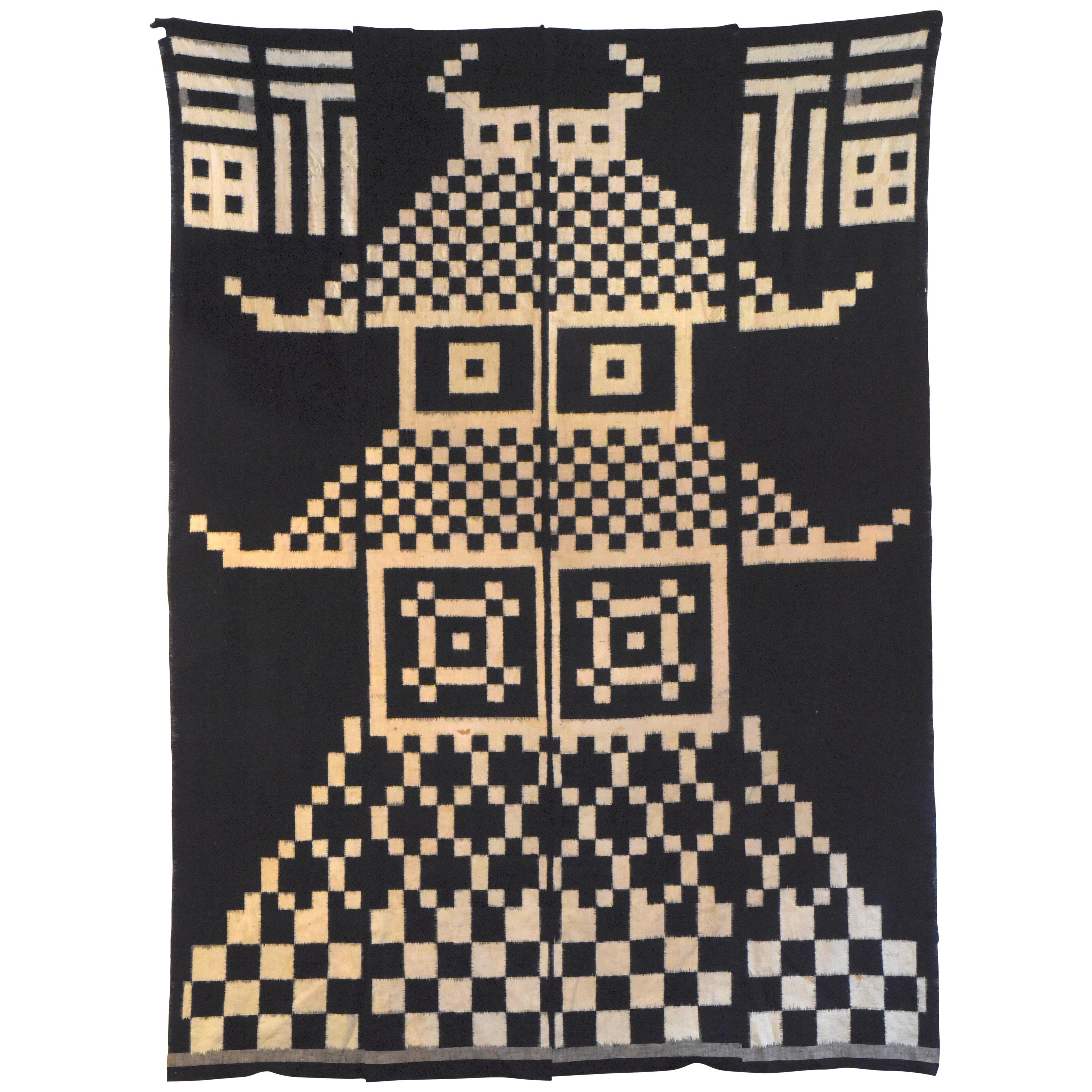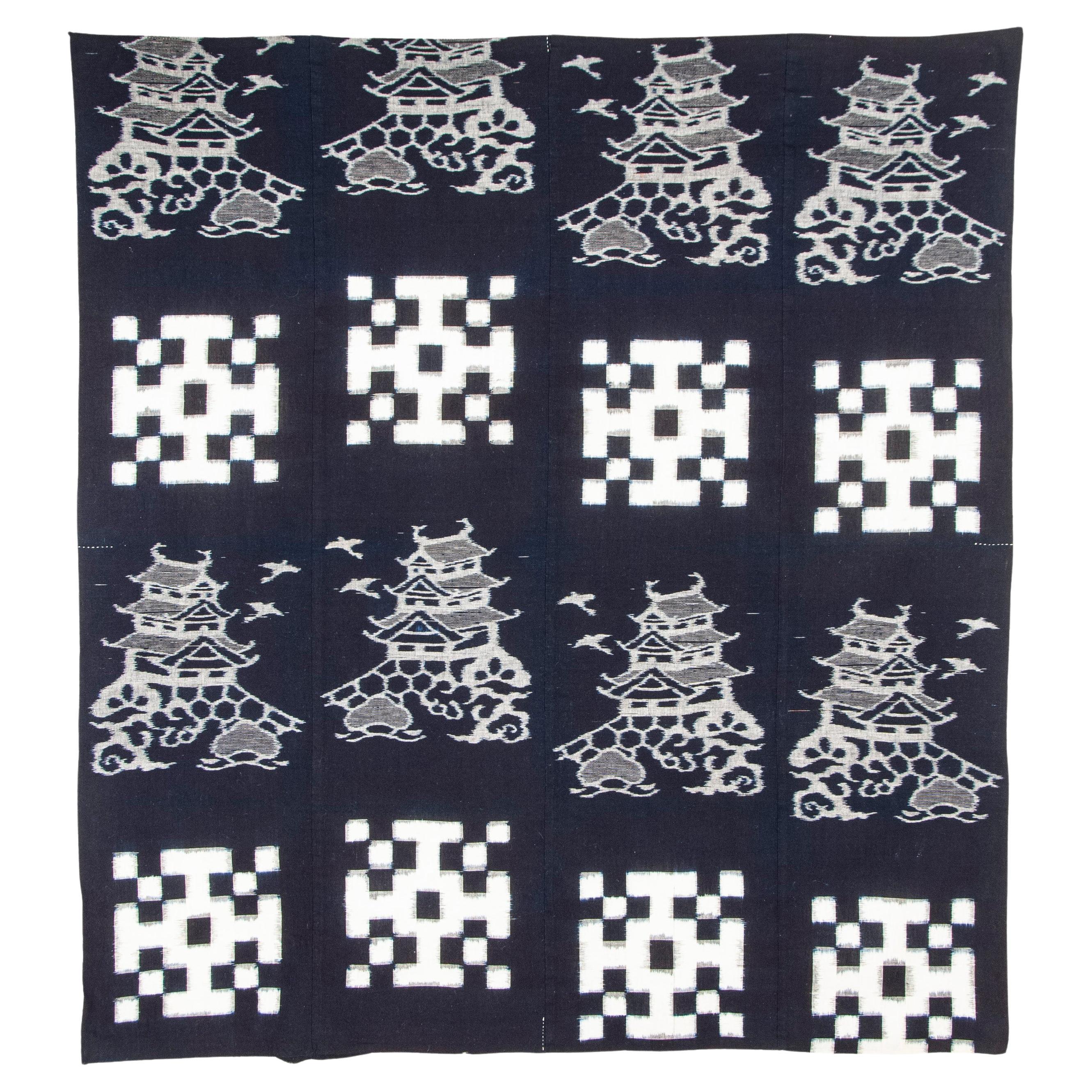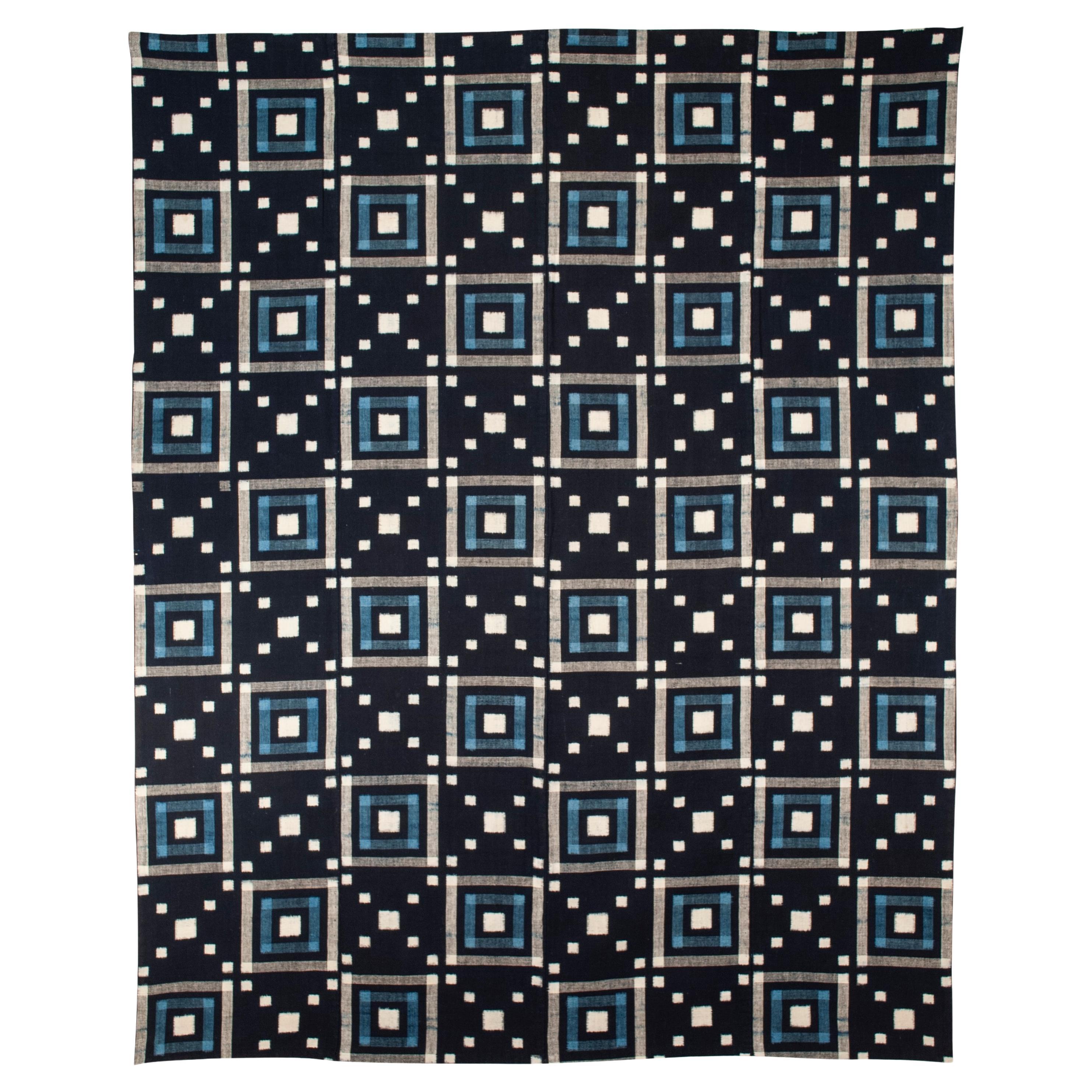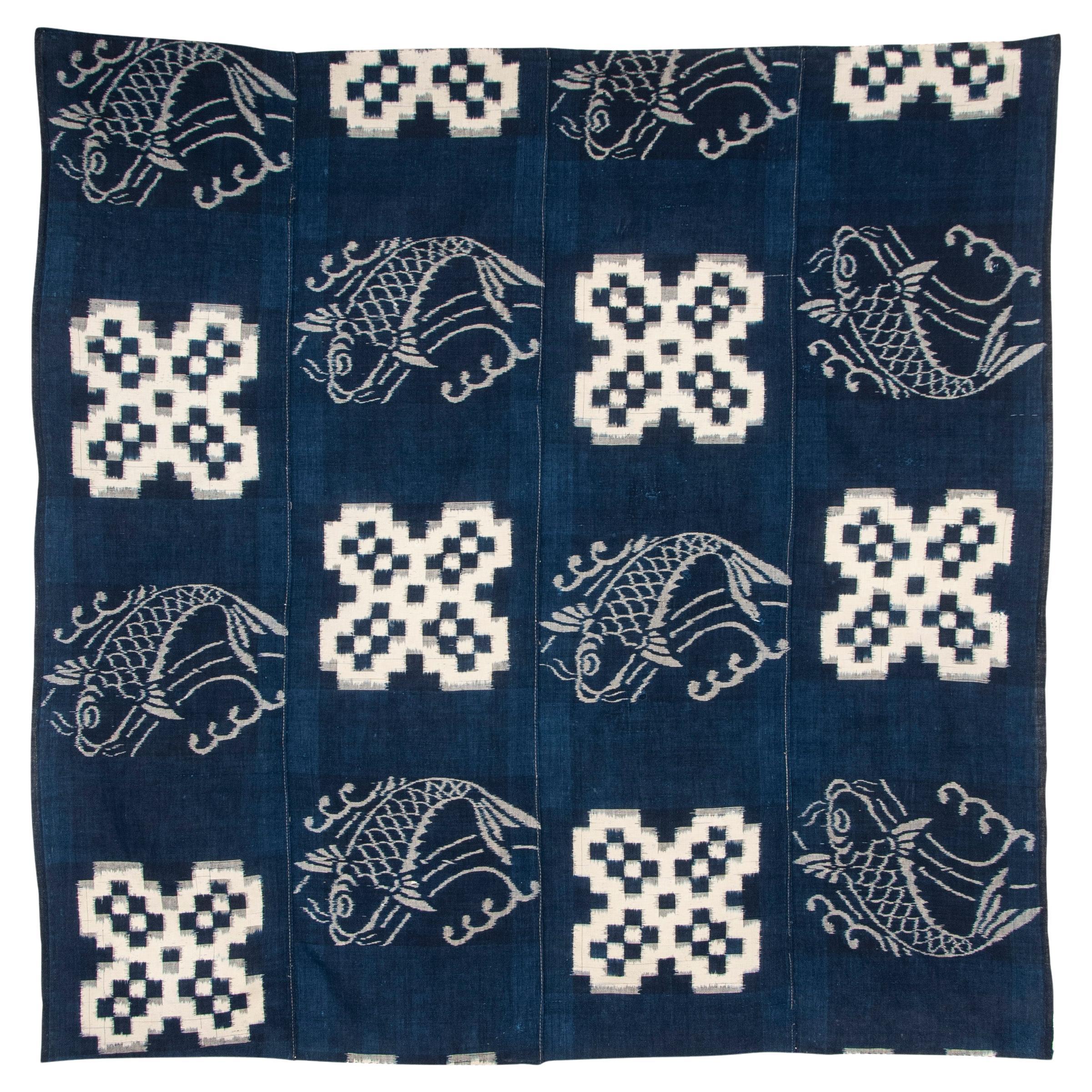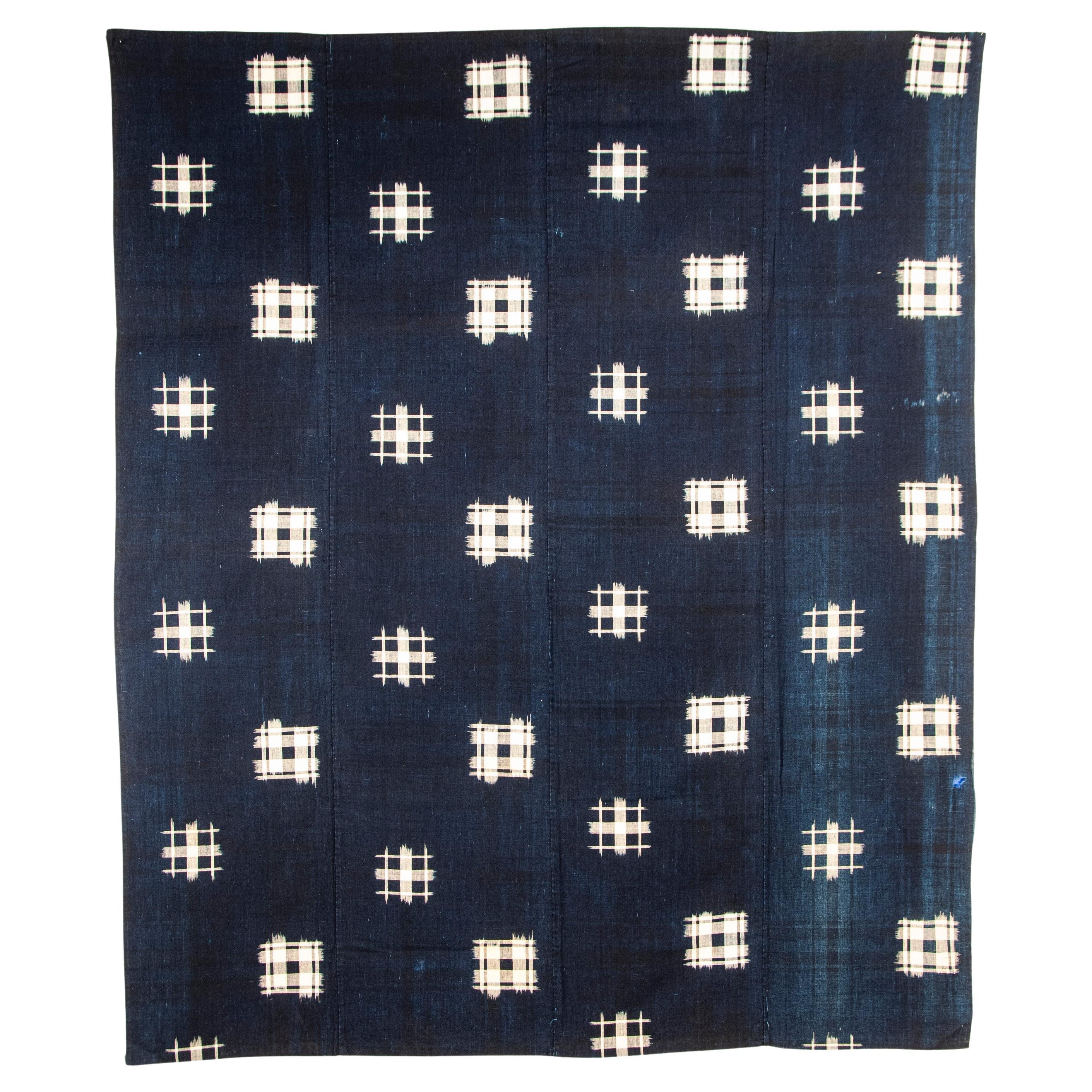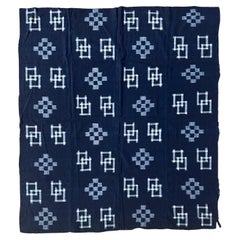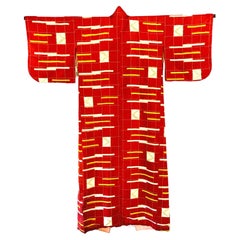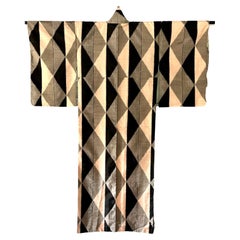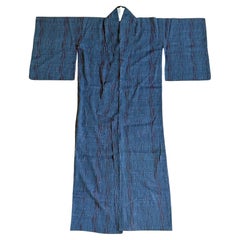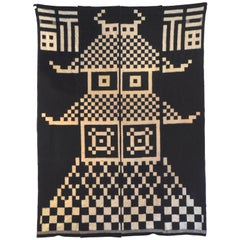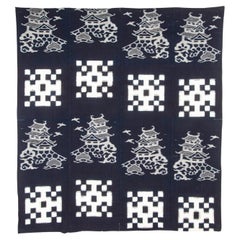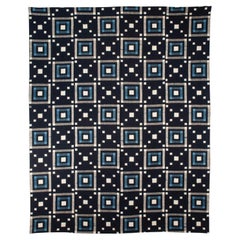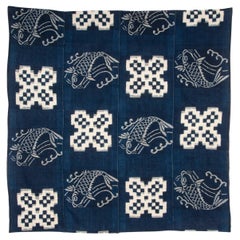Items Similar to Japanese Textile Panel Double Ikat Kasuri Futon Cover
Want more images or videos?
Request additional images or videos from the seller
1 of 13
Japanese Textile Panel Double Ikat Kasuri Futon Cover
$1,800
£1,365.80
€1,561.67
CA$2,514.11
A$2,795.35
CHF 1,459.58
MX$34,026.22
NOK 18,623.58
SEK 17,449.40
DKK 11,655.02
Shipping
Retrieving quote...The 1stDibs Promise:
Authenticity Guarantee,
Money-Back Guarantee,
24-Hour Cancellation
About the Item
A Japanese woven cotton textile panel with white pattern on indigo background circa 1900-20s (end of Meiji to Tasho period). The panel was joined by four vertical stripes and was traditionally used to make the Futonji (futon coverlet). The weaving technique is called e-Kasuri, in this case a double ikat (Tate-Yoko Kasuri; both wefts and warps were pre-dyed to create a perfect pictorial pattern on the loom). The precision of the resistant dye was the key for such textile. On the indigo background, the panel is covered with two repetitive alternate designs: one is a large geometrical pattern with quatrefoil petals and the other is a more delicate pictorial of a flowering plum tree in a bonsai. The width of the stripe was often restricted by the width of the loom used for such weaving, therefore the futonji was almost always joined by four stripes. The panel, albeit nearly a century old, appears strikingly modern and will make a great wall hanging.
For two similar Kasuri futonji, see "Textile of Japan" Prestel, page 306 and 308, illustration 105 and 106.
Ikat weaving was originated in Southeast Asia and spread to Japan Mainland in the 17th century via Okinawa (14th century). The cotton production accelerated the development of the textile industry on a much larger scale by then in the Edo period when Kasuri became very popular among the general population.
- Dimensions:Height: 57 in (144.78 cm)Width: 49.5 in (125.73 cm)Depth: 0.2 in (5.08 mm)
- Style:Meiji (Of the Period)
- Materials and Techniques:Cotton,Ikat
- Place of Origin:
- Period:
- Date of Manufacture:Early 20th Century
- Condition:Wear consistent with age and use. Good condition with expected light wear. Small pinhole-like wear scattered toward the edge. Frays on the edge per nature of the weave. Clean, no obvious stains or odor. Folding wrinkles.
- Seller Location:Atlanta, GA
- Reference Number:1stDibs: LU945038699112
About the Seller
4.9
Platinum Seller
Premium sellers with a 4.7+ rating and 24-hour response times
Established in 2006
1stDibs seller since 2010
564 sales on 1stDibs
Typical response time: <1 hour
- ShippingRetrieving quote...Shipping from: Atlanta, GA
- Return Policy
Authenticity Guarantee
In the unlikely event there’s an issue with an item’s authenticity, contact us within 1 year for a full refund. DetailsMoney-Back Guarantee
If your item is not as described, is damaged in transit, or does not arrive, contact us within 7 days for a full refund. Details24-Hour Cancellation
You have a 24-hour grace period in which to reconsider your purchase, with no questions asked.Vetted Professional Sellers
Our world-class sellers must adhere to strict standards for service and quality, maintaining the integrity of our listings.Price-Match Guarantee
If you find that a seller listed the same item for a lower price elsewhere, we’ll match it.Trusted Global Delivery
Our best-in-class carrier network provides specialized shipping options worldwide, including custom delivery.More From This Seller
View AllJapanese Textile Panel Double Ikat Kasuri Futon Cover
Located in Atlanta, GA
A Japanese woven cotton textile panel with white pattern on indigo background circa 1900-20s (end of Meiji to Tasho period). The panel was joined by four vertical stripes and was tra...
Category
Early 20th Century Japanese Meiji Textiles
Materials
Cotton
Japanese Art Deco Ikat Silk Meisen Kimono
Located in Atlanta, GA
A striking and well preserved Japanese Meisen kimono hand-sewn from woven Ikat Silk circa 1920-40s (Taisho to Showa period). The kosode style kimono (sma...
Category
Early 20th Century Japanese Showa Textiles
Materials
Silk
Japanese Art Deco Ikat Silk Meisen Kimono
Located in Atlanta, GA
A well preserved Japanese Meisen kimono hand-sewn from woven Ikat Silk circa 1920-30s (Taisho to early Showa period). The kosode style kimono (small slee...
Category
Early 20th Century Japanese Showa Textiles
Materials
Silk
Japanese Woven Asa Double Ikat Summer Usumono Kimono Provenance
Located in Atlanta, GA
A “Natsu No Kimono” (summer kimono) also called “Usumono" (thin clothes) dated from early 20th century Taisho Period. This well-preserved garment was tailored from a woven indigo blu...
Category
Early 20th Century Japanese Taisho Textiles
Materials
Linen
Japanese Woven Asa Double Ikat Summer Usumono Kimono Provenance
Located in Atlanta, GA
On offer is a “Natsu No Kimono” (summer kimono) also called “Usumono" (thin clothes) dated from early 20th century Taisho Period. This well-preserved garment was tailored from a wove...
Category
Early 20th Century Japanese Taisho Textiles
Materials
Hemp
Large Japanese Textile Futon Cover with Resist Yuzen Dye
Located in Atlanta, GA
A large unframed Japanese textile art circa late early 20th century toward the end of the Meiji period. Seamed together from four vertical sections of cotton in deep indigo color, th...
Category
Early 20th Century Japanese Meiji Textiles
Materials
Cotton
You May Also Like
Meiji Period Japanese Indigo Double Ikat Futon Cover
Located in Point Richmond, CA
Meiji period Japanese Indigo double ikat futon cover
Japanese futon cover, a double ikat pattern in four panels depicting Kumamoto Castle with im...
Category
Antique 1890s Japanese Meiji Textiles
Materials
Cotton
Antique Japanese Kurume Indigo-Dyed Double Ikat Futon Cover
Located in Point Richmond, CA
Antique Japanese Kurume Indigo-Dyed Double Ikat Futon Cover
Kurume double-ikat weaving was established over 200 year ago on the southern island of Kyushu, and has long been celebrat...
Category
Early 20th Century Japanese Taisho Tribal Art
Materials
Cotton
Antique Japanese Double-Ikat Futon Cover
Located in Point Richmond, CA
Antique Japanese Double-Ikat Futon Cover
This eye-dazzling hand-spun cotton, indigo-dyed 4-panel futon cover is a classic double ikat design displaying rows of concentric squares in...
Category
Early 20th Century Japanese Taisho Tribal Art
Materials
Cotton
Antique Japanese Kurume Indigo-Dyed Double Ikat Futon Cover
Located in Point Richmond, CA
Antique Japanese Kurume Indigo-Dyed Double Ikat Futon Cover
Kurume double-ikat weaving was established over 200 year ago on the southern island of Kyushu, and has long been celebrat...
Category
Early 20th Century Japanese Taisho Tribal Art
Materials
Cotton
Antique Japanese Indigo-Dyed Double Ikat Futon Cover
Located in Point Richmond, CA
Antique Japanese Indigo-Dyed Double Ikat Futon Cover
This early 20th century hand-spun cotton futon cover displays a pattern of scattered ‘well-head’ motifs across a deep indigo fie...
Category
Early 20th Century Japanese Taisho Tribal Art
Materials
Cotton
Early 20th Century Japanese Linen Go-Board Pattern Futon Cover
Located in Point Richmond, CA
Early 20th Century Japanese linen go-board pattern futon cover
A unique example of a game-themed textile, this 3-panel futon cover is woven of very fine...
Category
Early 20th Century Japanese Meiji Textiles
Materials
Hemp
More Ways To Browse
Antique Woven Textile
Textile Art Weaving
Ikat Fabrics
Large Textile Wall Art
Large Scale Textile Art
Japanese Weaving
Antique Cotton Scale
Four Panel Asian Art
Japanese Wall Panels
Antique Ikat
Antique Weaving Loom
Ikat Weavings
Antique Japanese Wall Panels
Japanese Indigo Textile
Antique Coverlets
Antique Woven Coverlets
Antique Japanese Indigo
Japanese Bonsai
